
In 1972 the man born Stelios Arcadiou took on a new name. He refashioned himself as the artist Stelarc, whose work often explores what he calls “alternate anatomical architectures.” He’s probed his body with cameras, creating films that lay bare the visceral inner workings of his stomach, lungs, and colon. He’s deprived his body, spending five days with his eyes and lips sewn shut. He’s manipulated his body with electricity, connecting electrodes to his muscles and letting others move him like a drunken, flailing robot. And he’s augmented his body through exoskeletons and prostheses, including a mechanical third hand.
In 1976 he embarked on a series of “suspensions,” piercing his skin with long metal hooks, then hoisting his body into the air. He’d hang in different positions, sometimes alongside other objects (including rocks); sometimes his body was still, while other times it swung free or was moved by motors. Sometimes he broadcast the sound of his heartbeat while hanging. He did 25 of these suspensions, in locations as varied as an Australian elevator shaft, a Tokyo monorail station, and the sky above E. 11th Street in New York City. As he described them, the events did not demonstrate an ability of consciousness to transcend the body, nor an S&M-style conversion of pain into pleasure. Instead, he said, these “body sculptures” erased the artificial distinction between mind and body. Overwhelming pain — the kind you might experience hanging from metal hooks — forces us to experience ourselves as physical bodies, to recognize that we are our bodies. At the same time, he writes, “Suspended and in stress the anonymous body realises its obsolescence.”
Over his career, Stelarc’s work continues to re-examine the possibilities of this obsolete body as a site for experimentation. His current project, Ear On Arm, is a surgically constructed ear grown from cells and attached to, well, his arm. The ear will eventually be connected to the internet, allowing anyone around the world to listen through it. He is currently Chair in Performance Art at Brunel University London. Via email, he offered his thoughts on the human body's obsolescence, the possibilities of self-directed evolution, and why he finds other species so fascinating.
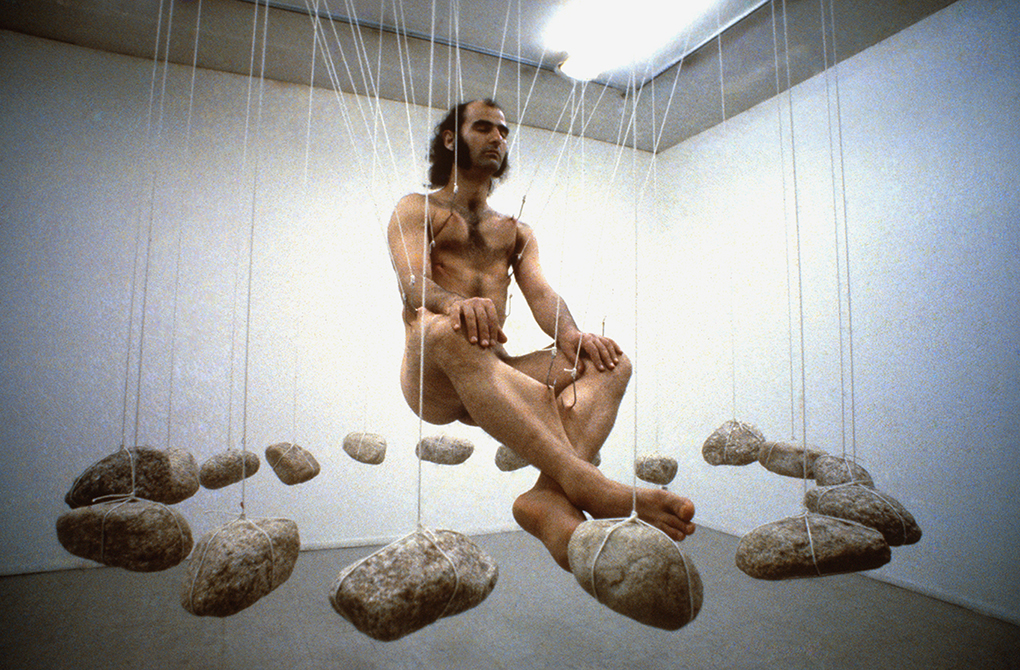
Your work consistently interrogates what it means to be human, to inhabit a singular human body. You've also described the body as "obsolete," titling several early works Obsolete Body. How do you mean that, and why is focusing on the body as a site of experimentation important to you?
Oh, I guess this body is the convenient site of experimentation without the politics of gender or the problematics of the ethics of the other. The body is both the medium of experience and expression. I’m also intrigued now with the idea of circulating flesh. That we can increasingly extract and exchange organs. That a face stitched onto the recipient body becomes a third face no longer resembling the donor. That we can take the skin cell from an impotent male and turn it into a sperm cell. Which means that it will be possible to take the skin cell from a female body and turn it into a sperm cell. We can indefinitely preserve a cadaver with plastination whilst sustaining a comatose body indefinitely on a life-support system. (We no longer die biological deaths, we mostly die from either catastrophic accidents or being switched off from our life-support systems). Now cryogenically preserved bodies await reanimation at some imagined future. There’s a proliferation of liminal states where what a body is and what a body does, needs to be interrogated. Issues of artificial intelligence, hybrid human-machine systems and avatars on the internet all generate questions of aliveness and what it means to be human. Certainly we need to consider the consequences and whether it’s even meaningful anymore to prolong and preserve the body in its present form and with these particular functions.
With the suspension performances it was not about any yogic control of the body, shamanistic prowess nor pseudo-spiritual pursuits. The realization in fact was that the body was profoundly obsolete, inadequate, empty, often absent to its own agency and generally performs habitually and involuntarily. But by obsolete, I don’t mean we can do without a body. Certainly this body with this form and these functions has limited capabilities, a brief life-span and is not very robust nor reliable. So the post-evolutionary imperative is to consider alternate anatomical architectures, alternate embodiments, and even experimenting with more chimeric constructs of meat, metal, and code to better operate in Mixed and Augmented Realities.
You mentioned the Suspension for Obsolete Body performances — hanging your body from the ceiling with a number of hooks. That event, as you say, emphasized both the vulnerability of the body, looking incredibly fragile as it hung in the air, but also its status as simple, inadequate "meat." Did you think of those early pieces as necessary steps toward your later work?
The performance immediately before the first suspension in 1976 involved stitching my lips and eyelids shut with surgical needle and thread, with the body connected to the gallery wall with cables fixed with hooks into the skin. The body was in the space for five days neither eating, drinking nor being able to see. In this performance and in the subsequent suspensions the body is seen as a sculpture, and with the suspensions the stretched skin becomes a gravitational landscape. There were 25 suspensions over a period of 13 years from 1976-1988. In varying positions (horizontal, vertical, sitting), in different situations (counterbalanced by a ring of rocks, spinning, swinging), both indoors and outdoors (Shaft Suspension; Seaside Suspension). The performances explored the physical and psychological parameters of the body. The realization of the body’s obsolescence and emptiness I guess conceptually enables the body to become a host for all the technology that could be attached and implanted within it. Having said that there was no linear progression of the physically difficult to the technically complex. The first works I made were helmets that split your binocular vision. And a rotating compartment that immersed the body with electronic sounds and images. I made three films of the inside of my body (probes into the stomach, lungs, and colon) between 1973-1975. And the Third Hand project began in 1975, a year before the first suspension event. So rather than a logical progression, there was rather an oscillation of concern between the physical and the technical. In fact earlier this year at the Scott Livesey Galleries in Melbourne, I did another suspension — spinning above a four-meter long Ear On Arm sculpture for 15 minutes. It reanimated the past suspension performances and also exposed the physicality of the Ear On Arm project.
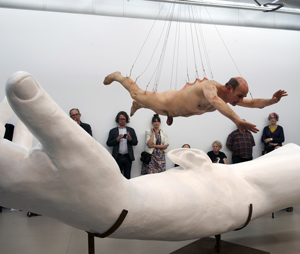
Ear On Arm Suspension. Photographer: C. Oyarce
"The body is seen as a sculpture, and with the suspensions the stretched skin becomes a gravitational landscape."

Fractal Flesh Diagram. Stelarc. Handswriting. Photographer: K. Oki
There's also a theme of self-directed evolution in your work: humans create technologies that take us beyond our naturally evolved capacities. So prosthetics play an important role, as means for extending human abilities. How do these prosthetics fit into your larger project?
Prosthetics are not a sign of lack but a symptom of excess. As technology proliferates, as it becomes biocompatible in both scale and substance, it can be attached and even implanted in the body.
Marshall McLuhan had a good definition of technology. Technology is the external organs of the body. We’ve evolved a body with soft internal organs. Now we are engineering additional components, capabilities and more intimate interfaces. The body has become an extended operational system, performing beyond the boundaries of the skin and beyond the local space that it inhabits. It’s become a kind of fractal flesh — bodies and bits of bodies, spatially separated but electronically connected, generating recurring patterns of online activity at varying scales. And as well as fractal flesh, it’s also a time of phantom flesh. With the increasing proliferation of haptics on the internet, we’ll be able to generate more potent physical presences of remote bodies with experience of touch, texture and force-feedback.
There are other kinds of cyborgian constructs. Perhaps all technology in the future will be invisible because it will be inside the human body. The body becomes a host for all its machines. With nano-scale sensors and nano-bots we can re-colonize the human body, augmenting our bacterial and viral populations. Aside from the post-human possibilities, the body requires a better internal surveillance system that better detects and alerts us of pathological changes in chemistry, temperature and cell growth. More radically we can undergo a kind of inverse embodiment, and redesign the body inside out, atoms up.
Stomach Sculpture was done for the Fifth Australian Sculpture Triennale, Melbourne 1993, whose theme was site-specific works. But instead of a sculpture for a public space I decided to make a sculpture for a private, internal space. It was inserted 40 cm into the inflated stomach cavity. The sculpture opened and closed, extended and retracted and had a flashing light and a beeping sound. So you have to imagine this as a machine choreography inside the body. Blender was the inverse to the Stomach Sculpture. This was a machine installation that became a host for a liquid body, composed of biomaterial from 2 artists’ bodies. Blender (2005 for Technikunst in Melbourne) was a collaboration with another artist, Nina Sellars, where both artists had 4.6 litres of biomaterial removed from their bodies. Once every five minutes the blender blades were activated by compressed air, mixing the biomaterial. A work in progress is engineering Microbot, an insect-like six legged walking robot, small enough and robust enough to walk up my tongue and into my mouth. I just have to remember not to swallow. (We are constructing several additional robots, just in case).
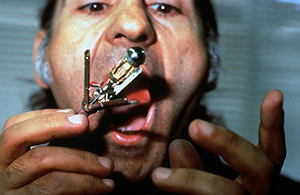
Stomach Sculpture. Photographer: A. Figallo

Stomach Sculpture Diagram, Stelarc.
Do you find anything striking about insect anatomies? They appear relatively often in your work, and seem one of the more radically different anatomical architectures one could choose.
Oh, I’ve always been fascinated by the multiplicity and diversity of insect, bird as well as animal anatomies. And how these alternate architectures enable unexpected operational capabilities. These architectures sometimes seem excessive with their multiple limbs, massive jaws and multi-lens vision systems. They vary from soft, squishy bodies covered in fine hairs to soft interiors clothed in exoskeletons. And although insects are individually simple architectures with relatively small brains their social interaction and swarming capabilities have been computationally simulated and applied to micro (and in the future nano-bots) as an alternate and more flexible operational strategy in robotics. Not to mention the flocking behavior of birds. There’s so much to learn from other species and anatomical architectures and how they can be translated into machines and robots. Legged locomotion is increasingly used in robotics to engineer more effective rough terrain machines. And then there’s the elegant simplicity of a snake that in its single cord structure is both a locomotor and manipulator all in one. The snake can slither along a surface with its sinusoidal motion but it can also wrap around a prey and tightly squeeze it — not to mention disengaging its jaws to swallow an animal much larger than we could ever imagine it could manage. Being such an elegant design has seen robotic snakes being engineered, but for unexpected uses. For example, as a large universal segmented limb (like an elephant’s trunk) that can lift a hospital patient from one bed to another or in a miniature form as an endoscope that can more smoothly slither down into a bodily tract. This kind of approach to robotics can be exemplified in the work of Shigeo Hirose at Tokyo Institute of Technology. Then there’s a more hybrid approach seen with the Wheg robots at Case Western Reserve University. These robots have combination wheels and legs (whegs) that enable them to move very fast on flat surfaces but in addition they can clamper over obstacles or even climb up stairs.
That McLuhanesque notion of prosthetics as a symptom of excess sheds light on your usage of them. Rather than prosthetics simply extending or mimicking human abilities, in your work they create new "connections" between body and machine. The Third Hand connected not to an arm, but to your leg and abdominal muscles, while Ear on Arm obviously puts the auditory organ in a new context. What do you hope to reveal by tinkering with the body's architecture this way?
The Third Hand (1980) had pinch-release, grasp-release and 290-degree wrist rotation clockwise and counter-clockwise. It also had a tactile feedback system for a rudimentary sense of touch. By actuating the Third Hand with the EMG electrical signals of the abdominal and leg muscles, it was possible to have independent movement of the three hands. At first merely a visual attachment, later attempts were made to write and draw with 3 hands simultaneously. The body is simultaneously encumbered and extended with an additional hand. But the difficulties are simple ergonomic ones that are improved with the use of lighter materials and using dry electrodes to minimize skin irritation. At the time of its completion, the Third Hand was state-of-the-art technology and I was invited to do demonstrations at the Jet Propulsion Lab in Pasadena and the Johnston Space Centre in Houston to the Extra-Vehicular Group. The Extended Arm extends the artist’s arm to primate proportions. As well as wrist rotation, thumb rotation and finger flexion, each finger splits open. Each finger is a potential gripper, multiplying the use of the hand.
With the Ambidextrous Arm (a work in progress at Brunel University, London) each finger is double-jointed and the thumb rotates in both directions. That becomes a universal manipulator. Simultaneously a left hand and a right hand all in one design. As a prosthetic hand, the amputee could function sometimes with a left and a right hand or with 2 left hands and/or two right hands. And the hand could simultaneously grip separate objects on both sides of its palm. With an eye-in-hand webcam, the ambidextrous hand would be a seeing as well as gripper device. What’s interesting is what generates aliveness, how motion can also indicate affect (e-motion). Having additional attachments or wearable exoskeletons re-animate the body, going beyond its evolutionary range of movements and operations.
And by adjusting the body’s architecture you adjust its awareness of itself and its environment. This allows us to re-think and re-evaluate the body whilst re-working its operational capabilities. And of course these robotic or prosthetic attachments need to be proximal to the body but can be actuated remotely as end-effectors. The task envelope of the body now radically extends to remote physical locations but also to managing data streams in virtual spaces.
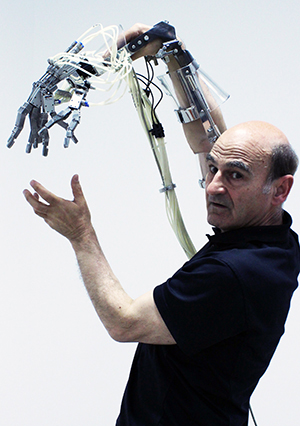
Extended Arm. Photographer: D. Winter

Third Hand Diagram. Stelarc.
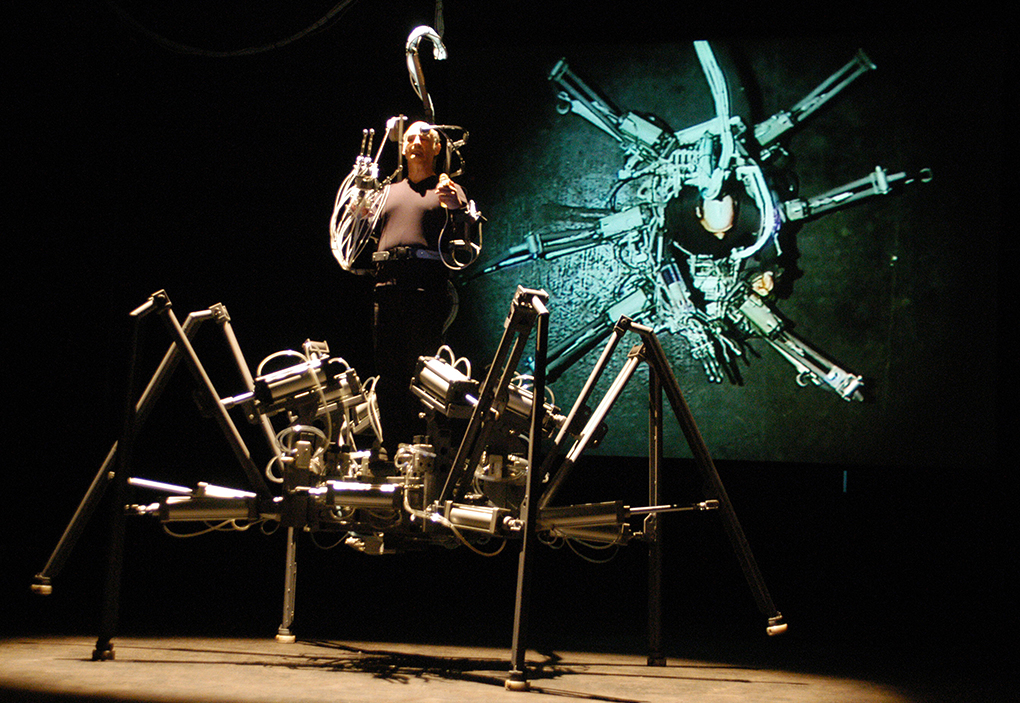
Obviously you've explored the body's limitations in many ways, and looked to extend the spectrum of bodily experience. A work like Exoskeleton, a six-legged, pneumatically powered walking machine, seems particularly about translating movements of the human form into another, mechanical anatomy. Muscle Machine involved a somewhat similar approach, though this time with a more direct linkage that made it less clear whether the man moved the machine or vice-versa. That seems to complicate the operator's relationship with his own body — and perhaps, by extension, the spectator's sense of embodiment. What intrigues you about these kinds of feedback loops?
Both of these projects translate human bipedal gait into 6-legged insect like locomotion. But the control systems and feedback loops are different. As are the experiences of symbiosis. With Exoskeleton the leg movements are selected by the artist’s arm gestures. The robot can walk forwards and backwards with a ripple gait and sideways with a tripod gait. It can sit, stand and turn on the spot. The body and walking chassis of the Muscle Machine are more directly linked as encoders on my hip joints result in the machine responding to my leg motions. So lifting one leg up lifts three robot legs and swings them forward. By alternating my left and right leg the machine moves. There are sensors embedded within the chassis that detect the direction and body faces and the machine always walks in that direction. The performances are simply about taking the robot for a walk.
But yes, it’s strange navigating the performance space with six legs instead of two and the large space that the robots inhabit. Exoskeleton is three meters in diameter and the Muscle Machine is five meters in diameter, making them difficult to maneuver in limited spaces. Also both machines are sound systems with their mechanical sounds and the pneumatic hissing and solenoid clicks amplified. So you not only look where you are walking the robot but you also listen to the sounds you are generating. To compose the sounds you choreograph the movements of the machine.
The Prosthetic Head project dispensed with a body altogether, projecting a head that looked much like your own onto a large screen and allowing visitors to interact with it through a keyboard, “speaking” to it through text. This seems like the ultimate disembodiment — a Max Headroom-style simulation of a human face, with (nearly) all its expressive potential, but none of its corporeality. Yet all of that “expression” came about in part thanks to lines of computer code, suggesting that human bodies too are simply “running code.”
The Prosthetic Head is an embodied conversational agent. It has a database and a conversational strategy that enables it to speak, with facial expressions, to the person who interrogates it.
There were several reasons why it was only a disembodied head without a body. Firstly I felt that as a conversational system that speaking and facial expressions were adequate. And secondly, to emulate a whole body with the problems of limb movements and appropriate hand gestures would be difficult to achieve with any fidelity. The Head was not meant to be illustrative of an AI but to be simply a conversational system. That is coupled to a human head, it’s able to generate plausible and interesting responses. Certainly the notion of bodies simply running code is seductive, or that we can adequately operate as code, or that we might be able to upload or download bodies as code are interesting ideas. They are also highly problematic as a body is what it is not only because of its DNA code and carbon chemistry but also because of its physiology and its social interactivity. To be an intelligent agent you need to be both embodied and embedded in the world. Not to mention also needing to be massively augmented with instruments and machines to achieve what we consider human potential. But as part of the Thinking Head Project (led by the MARCS Labs at the University of Western Sydney), the Prosthetic Head has generated alternate physical embodiments. The Articulated Head has an industrial robot arm torso (or 6 degree of freedom articulated neck) that enables real-world behavior augmenting its virtual movements. An attention model was also developed that made it a more seductive interactive agent. The Floating Head (a collaboration with NXI Gestatio, Montreal) was a flying robot embodied with the Prosthetic Head and the Swarming Heads (MARCS Robotics Lab) are a cluster of smaller robots which interact with each other and that can be guided by gestures with the onboard Kinect sensor.

Articulated Head. Photographer: C. Kapor
The question of individuality also runs through your work. As technology increasingly embeds us in "networks" and permeates our bodies, it's natural to wonder about the boundary between self and environment. With Ear on Arm, you hope to eventually create "an Internet organ for the body," through which people around the world can listen. Are bodies becoming less houses for our individual selves, and more nodes in a global network? I'm resisting a comparison to the Borg here, but how do you see notions of individuality playing out within this network?
There’s always been an interest in the body not as a site for the psyche nor for social inscription but merely as a structure. The body not as an object of desire but an object that might be re-designed. Certainly bodies are individuated but should not be considered individuals in the generally accepted sense. In fact the more and more performances I do the more and more I think that I have no mind of my own nor any mind at all in the traditional metaphysical sense. When this body speaks as an “I” this body does so knowing that is a convenient language construct for a much more complex and interactive situation of this body with other bodies and technologies. Nietzsche asserts that there’s no being behind the doing (it’s the act itself that’s meaningful) and Wittgenstein states that thinking does not need to be located in the head. (Thinking occurs with the lips that we speak with, on the paper that we write on and now on the keyboard that we type with).
Certainly bodies become nodes in a global network and bodies are increasingly hosts for remote agents. Just as the private / public domains are increasingly blurred, so is the individual and the collective. And the actual and the virtual. Our identities are now constructed by our connectivity, our online presence and remote inter-activity. We are neither all-here, nor all-there, but rather partly-here and partly-there. We are no longer bounded by our skin and by the local space that we inhabit. It’s now quite plausible that people will become portals for remote experience. Imagine my body in Melbourne seeing with the eyes of someone in London, hearing with the ears of someone in New York, whilst someone in Tokyo is remotely accessing and remotely actuating my arm to perform locally. Of course we would need to take measures against our bodies being hacked, just as we now need to take precautions against identity theft. William Gibson has an interesting observation of the future — it’s already here, it’s just not evenly distributed yet...
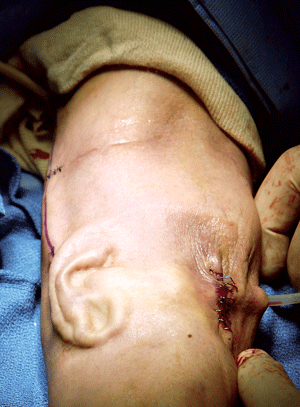
Ear On Arm Surgery. Photographer: N. Sellars
"Bodies are increasingly hosts for remote agents."

I hate asking anyone to make predictions, so I'll put it this way: along with hearing through ears in New York and seeing through eyes in London, what new ways of thinking about the body would make for an intriguing future, of the type you'd want to live in?
Well, we are increasingly expected to perform in mixed and augmented realities. Sometimes primarily as biological bodies, often augmented by our instruments and accelerated by our machines, and we have to manage data streams in virtual systems. To effectively multitask, we have become hybrids of meat, metal and code. We constantly shape-shift for different task envelopes, becoming fluid prosthetic embodiments and alternate identities. In addition to this experience of the body becoming an extended operational system whose sensory and motor functions being distributed, the body also literally becomes a split body — not a split mind and body but in actuality a split physiology. Partly actuated by its own agency, partly actuated by people in other places. So any body can become a host for a multiplicity of remote agents. That’s an exciting possibility. The internet, imbued with AIs, vision systems, other sensors and the proliferation of haptic devices generates unexpected possibilities of bodily interactions, force feedback and alternate awareness. So as well as augmenting individual body architectures we are engineering multiple body interactions. As well as constructing intelligent systems and responsive spaces we need to consider redesigning the body so that it can better augment and interface, enabling it to match the performance of its machines.
As an artist, what’s important is not affirming, but interrogating. Not enabling but generating ambivalence and uncertainty. We need to create contestable futures that can be examined, evaluated, sometimes appropriated, often discarded. We are curious creatures. What it means to be human is perhaps not remaining human at all. Rather than affirming our human phylum we need to interrogate what it means to become an alien other, both in form and in function.
Photo credits:
Ear On Arm. Photographer: N. Sellars
Rock Suspension. Photographer: K. Oki
Exoskeleton. Photographer: I.Skafar
Stretched Skin. Photographer: G. Baring